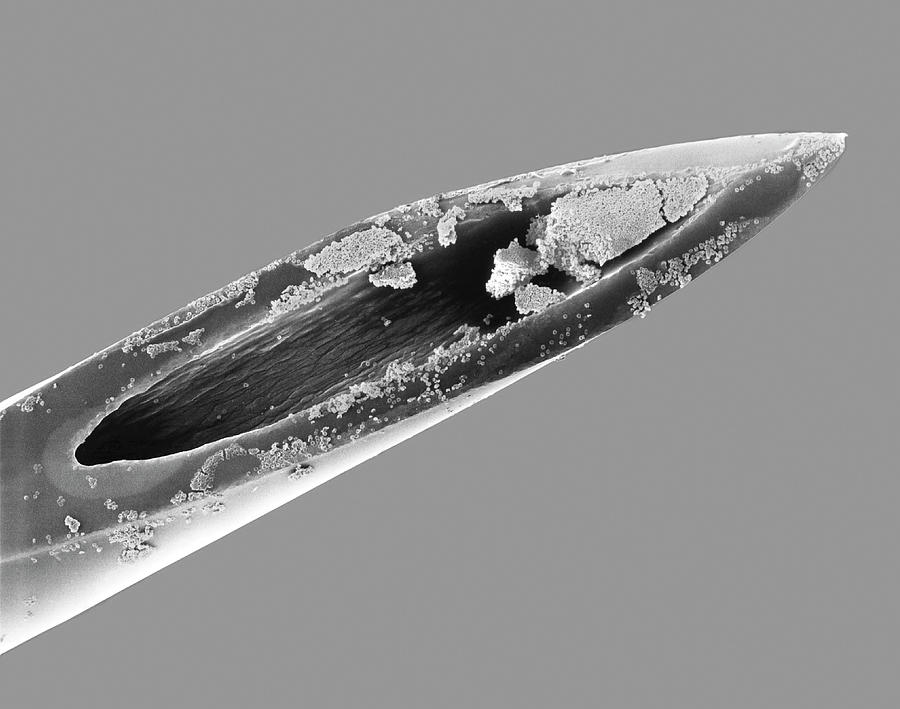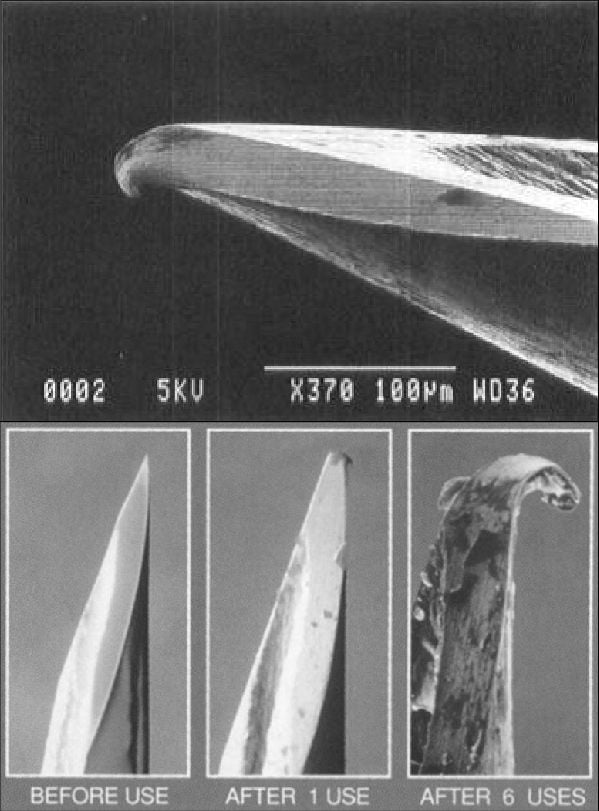The colors are added in, of course, with it being an electron microscope image. Another picture:

Its crazy how crude all of our tools look at this magnification.
Some medical tools look crude even at regular size… they don’t call orthopedics bone carpenters for nothing!
People would never set foot in a hospital again if they found out how many orthopedic surgeries involve a dewalt drill at some point.
My knee replacement was carried out with an epidural pain block, plus sedation. I came down from cloud nine briefly to wonder why someone was doing renovations while surgery was in progress - then realised all the drilling and hammering was my new joint going in. Phew! Back to lala land…
Lmao “oh shit I’m a house”
I’m just going to leave this discovery here.
That’s great. I rotated through an ortho lab in the 1990s, and the joint replacement kits back then included a sterile, disposable drill that you were just supposed to throw out after the procedure.
I recently saw a knee replacement that used one of those ryobi oscillating cutters (the ones that were super trendy a few years back). Total garbage for home use, but man with a 3D printed cutting guide shaped to fit over the bone, they finished the osteo and arthroplasty portions in ten minutes flat. Just insane what we can accomplish when we combine modern volumetric imaging techniques with coupons for home depot.
I’ve seen enough joint replacement videos, especially knees, to think carpentry skills are a job requirement.
Well at least they’re not using a store brand.
My hospital buys from Harbor Freight!
Basically same as Orthodontists or Dentists. Once you arr knocked out, pray to not come back earlier :p
I’ve started calling folks taking X-rays the bone paparazzi.
I guess that’s better than calling neurosurgeons spaghetti artists
I gained an appreciation for how precise/sharp our tools are when I learned microtomy. If you so much as touch the cutting edge with anything outside of its intended use it messes up that area of the blade instantly. Same goes for a nice pair of chef’s knives.
I’ve had 2 ACL reconstructions, but the first knee surgery I had was a scope. The surgeon allowed me to stay awake and it was freaking awesome to watch the little grinder and vacuum at work!
Damn, I wouldn’t have been able to take that. I would have told them to put me the fuck out rather than have to see and hear it and realize that was my knee they were doing that to. Even though it was to make things better.
It actually looks a LOT smoother and sharper than I expected. Look at microscope photos of razors and knives and they look like chewed up chisels.
I believe it’s damaged by piercing the skin, it’s pristine before.
Yet it emphasizes just how precisely tiny the tip of the needle is.
for this magnification it is actually pretty smooth
source: I have used an SEM at my university and never saw something this smooth even at higher magnifications
of course I didn’t look at medical tools but this shows that they are crafted very precisely
Crude aspects of fleshy meatbags.
From the moment I understood the weakness of my flesh, it disgusted me. I crave the certainty of steel.
certainty of steel.
Yeah… take a few material courses in engineering…
It’s not so certain a lot of the time…
I crave the certainty of neutronium
The quality of steel has generally gone down in the last hundred years. I’m not trying to dunk on China specifically because cheap steel is manufactured in more places than just there - but I recently saw a stress test of a cheap modern maul made from Chinese steel vs a 100 year old American maul and it’s like they aren’t even in the same category. The old ones were indestructible.
The purity of the blessed machine
Glory to the Omnissiah
The flesh is weak, but deeds endure

username is Gork
haha yes I am very human too and i too hate it when my skin gets damaged and needs to be replaced because it invokes a feeling called pain and it is a very unpleasant feeling
See that little hook at the point? This is from penetrating skin ONCE.
This is why you don’t re-use needles folks!

There are other reasons.
Holy shit. I noticed that too and thought that must be one of the ones that hurts going in, figured it was from when they draw the medicine into the syringe,. Or may e even from taking the cap off.
In that last one, you’d probably be able to see the bent over tip with the naked eye. You’d certainly be able to feel it if you ran your finger over it. It would take some force and would be pretty painful to use.
This is fascinating. I mean we all know the theory, but to actually see the cells under magnification puts you in range, and makes you wonder what else there is to know. And the answer is always MORE.
Education should work more practical application in with the theory. I’m looking at you, calculus!
Seriously. I’m in my 40s and this is the first time I’ve ever had any sense of scale for red blood cells. Very cool!
But it’s hard to perceive the scale of the needle tip itself, so there’s no good reference object for the scale. They should have included banana or something for the comparison.
Mmmmm red caviar … 😋
how were the colours added? like do you carefully select each isolated cell to add the colour or is there some kind of algorithm?
When I segmented 3D MRI and CT scan images before I used the contrast borders for help a lot. There were some algorithms for finding edges that you could tune by setting search radiuses and thresholds. There was also an option of growing an area by a certain amount of pixels outward, and then threshholding the result back down to only the brighter parts, that kind of thing. You had to be a little clever about how you’d combine it. And ultimately, sometimes I just had to add and subtract a few points manually.
Segmenting is more assigning areas to distinct objects (separating bones from the rest in my case), but you could totally use it as a basis for coloring, so I assume the process is similar here.
These are manufactured differently from most of the stuff you’d be looking at.
Rather than milling and grinding, the needles are made from a sheet of stainless that’s rolled and welded, then drawn down to whatever size it needs to be, basically stretching the material out. Kinda like when you make a snake with silly puddy and pull it apart.
Then the points are ground in. Gives you a ridiculously smooth finish.
Interesting info, thanks!
But I think you may have accidentally typed in the wrong thread? I was talking about the image manipulation, not the manufacturing :-)
Extrusion?
Thank you for the caption. My fist thought was “how did they take this photo in color?!?”
I actually thought optical microscopy worked just fine at this scale.
I know it’s not the case for this photo, but if a 7 μm red bloodcell is reflecting red light (700nm, aka 0.7μm) under a bright white light, wouldn’t the smallest discernable detail of the red blood cells be about a 10th of its width? Is that not roughly the detail we have in this image?
I’m making an assumption that the distance between discernable parts roughly parallels the wavelength’s width. I could be wrong tho
Looks like Nerds. Nerds running the whole operation.
Nerds always run the whole operation 🤓
I wonder what gauge needle that is?
At very rough estimate, I would guess a 30 gauge needle. They have an outer diameter of .31 mm. A blood cell is about 7 micrometer across. It looks like you can fit more a smidge fewer than 50 cells across the thickest part of this needle. Cheers!
I want to eat a red blood cell. Like one the size of my hand that tastes like a gummy bear
Can’t you just eat some real gummy bears? I think they even make big ones.
Frighteningly big.

Please do not buy your child a gummy bear bigger than their head. We have enough problems with diabetes as it is.
Or use your own blood to make gummy bears from it.
Or buy regular gummy bears, put in a bath of your blood and let them swell up!
You’ve just given me a horrible idea.
It actually does sound frighteningly delicious though…
Would probably taste like a rusty nail, but gummy.
It’d probably be like eating a raw egg with most of the shell removed.
Where is the plasma?
I’m assuming if the syringe was wet before being placed in the microscope, the vacuum of the chamber would cause most of the water in the plasma to vaporize. The remaining salts and compounds would be much smaller than the red blood cells. The density of the red blood cells would be much larger than any remaining plasma, so the bulk of your backscattered electrons will be coming from the cells and needle, making the plasma essentially transparent. This is a fairly low magnification image for SEM, but that’s how you get such fantastic depth of field.
I didn’t know electron microscopes use a vacuum chamber.
The previously donated it.

As a type 1 diabetic I really hate this
Yes, some manufacturers of needles have less stringent QA than others. Moved to a new area and the local NHS disallow my usual brand due to cost… Will get to try something else… Hopefully not too bad…















